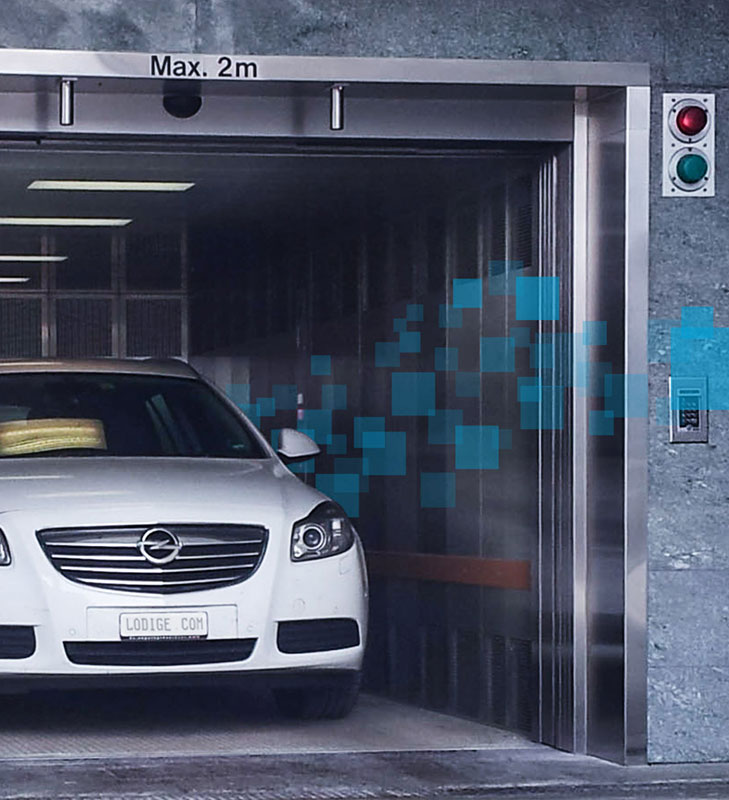Improving the seismic resistance of car elevators is the key to ensuring their normal operation and safe use under extreme conditions such as earthquakes. Since car elevators carry a large weight and involve multiple mechanical and electrical systems during operation, it is particularly important to enhance their seismic resistance.
The main structural parts of car elevators, such as frames, guide rails, support columns, platforms, etc., should be made of high-strength steel (such as Q235B, Q345B or higher strength grades of steel) to improve the strength and rigidity of the overall structure. High-strength steel can withstand the shear and bending forces generated by earthquakes and reduce the risk of deformation or fracture.
In some key components, such as hydraulic cylinders and bearings, seismic-resistant alloy materials such as stainless steel or high-strength alloys can be used. These materials can maintain good toughness under high stress and avoid cracks or fractures caused by vibration.
Between the guide rails, platforms and machine rooms of car elevators, shock-proof rubber pads or elastic shock-absorbing pads can be used to reduce the direct transmission of vibration to the core components of the elevator. Rubber pads can effectively absorb vibration energy and reduce stress concentration in structural components.
For example, polyurethane foam or silicone filler is used at the support base or foundation of the lift. This material not only has shock absorption function, but also can effectively absorb high-frequency vibration and reduce the impact on the lift.
In order to prevent structural damage caused by post-earthquake humidity or post-earthquake corrosion, the use of corrosion-resistant coatings (such as epoxy resin coatings, galvanized coatings, etc.) can effectively extend the service life of the car lift and maintain the stability of the structure.
Especially for mechanical parts that are easily affected by vibration, such as motors, hydraulic system components, etc., anti-seismic coatings are used to enhance the durability and shock resistance of the material.
Application of high-temperature resistant and shock-resistant materials
In high-temperature environments, the seismic resistance of materials may decrease. Therefore, when selecting materials for components of electronic control systems and hydraulic systems, it is particularly important to select high-temperature resistant and shock-resistant materials. For example, aluminum alloy materials or heat-resistant steel can maintain good stability at high temperatures and reduce structural problems caused by thermal expansion.

The frame of the car lift should be designed as a relatively rigid structure, especially the lifting platform, guide rails and support columns, etc., to increase its ability to withstand vibration. In the frame design, the use of cross supports, stiffening ribs and other strengthening structures can disperse the impact force brought by earthquake waves and prevent structural deformation.
The connection between key structural components should be made by high-strength bolts or welding to ensure that the connection components will not loosen or break during vibration.
Introducing dampers and shock absorbers
In the structure of the car lift, designing dampers or shock absorbers can effectively absorb the energy brought by earthquakes. Common shock absorbers include:
Hydraulic dampers can be installed in the support system of the lift to absorb the energy generated during vibration.
Spring dampers are installed between the guide rails or lifting platforms and the building structure to reduce the transmission of vibration to the car lift.
By optimizing the design of the car lift, its center of gravity is lowered as much as possible to avoid excessive tilting torque during vibration and ensure that the car lift remains balanced during earthquakes.
The foundation of the car lift should be reinforced to ensure its stability. In the building structure, the foundation needs to be designed as a seismic foundation, using a seismic foundation cushion or reinforced concrete foundation to make the entire lifting system firm and stable.
Optimize the seismic design of the lifting track
The track system of the car lift must be able to withstand the vibration impact caused by the earthquake. Therefore, the design of the track should fully consider the seismic resistance. When designing, you can:
Use U-shaped track or box-type track structure to improve the stability and bending resistance of the track.
Ensure that the connection parts between the track and the supporting structure are strong enough to avoid the track loosening during the earthquake.
Design elastic support so that the track can have a certain amount of activity space during the earthquake to avoid deformation of the track due to excessive vibration.
In the car lift, the integrated intelligent monitoring system can monitor the state of the structure in real time and automatically adjust the operating state of the lift when vibration or abnormality is detected. For example, the system can automatically stop running and notify maintenance personnel to check through intelligent alarms.
Use the automatic adjustment system to enable the car lift to automatically adjust the height or position of the lifting platform when encountering earthquakes or strong vibrations to reduce the impact of vibration on the car lift.
The seismic resistance of the car lift can be greatly improved by rationally selecting materials and optimizing structural design. Using high-strength, earthquake-resistant materials, designing a structure that is both rigid and elastic, and adding shock-absorbing, damping and other equipment can effectively improve the earthquake resistance of the car lift and ensure its safe and stable operation in extreme situations such as earthquakes. This can not only extend the service life of the car lift, but also ensure the safety of users.











